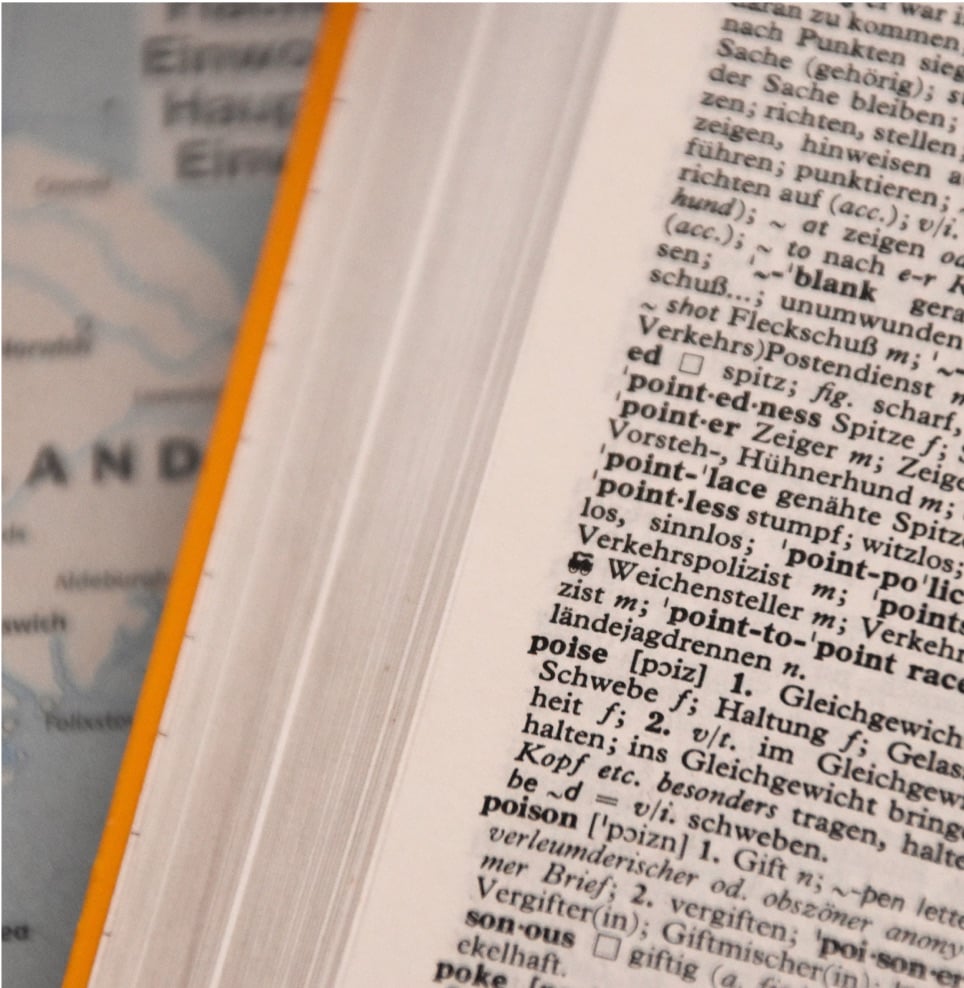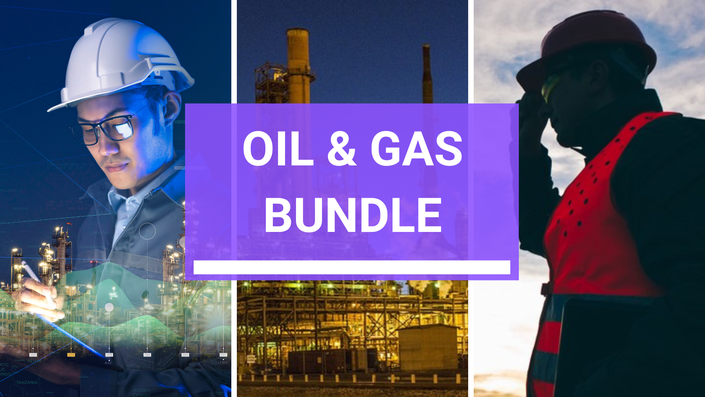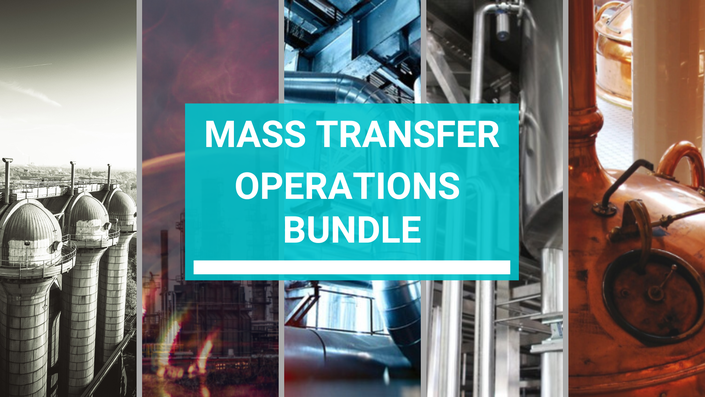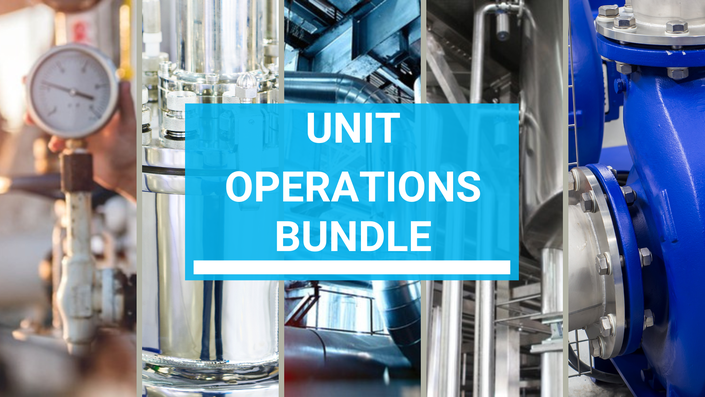Course Trailer
About this Course
📚 This Mass Balance: Practice Problems course is designed to reinforce your understanding of mass balance through a series of hands-on exercises, focusing on its practical application in real-world chemical engineering processes. You will tackle various mass balance problems commonly encountered in the industry, honing your problem-solving skills and gaining confidence in applying mass balance techniques to optimize chemical processes.
Key topics covered include:
- Review of Mass Balance Fundamentals
- Mass Balance in Different Unit Operations (Reactors, Heat Exchangers, Distillation Columns, etc.)
- Solving Complex Mass Balance Problems
- Applications in Steady-State and Unsteady-State Systems
- Material Balances with Reactions and Separations
- Troubleshooting Process Issues Using Mass Balance
👨🏫 Designed for
Chemical engineering students, process engineers, and professionals looking to practice and deepen their understanding of mass balance techniques in various real-world applications.
📚 Course Approach
The course focuses on problem-solving and practical application, providing you with a collection of carefully selected practice problems that range from simple to complex, covering a variety of chemical engineering processes. Step-by-step solutions are provided to guide you through the problem-solving process.
🎯 By the end of the course, you will be able to:
- Apply mass balance concepts to a wide range of chemical engineering systems
- Solve mass balance problems involving different unit operations
- Analyze systems at steady-state and unsteady-state conditions
- Use mass balance techniques to troubleshoot and optimize chemical processes
- Build confidence in solving real-world chemical engineering problems
🚀 Recommended for
Students and professionals who have a basic understanding of mass balance and want to strengthen their problem-solving skills through hands-on practice in various chemical engineering processes.
✅ You’ll learn to:
- Solve mass balance problems in reactors, heat exchangers, distillation columns, and other unit operations
- Apply mass balance techniques to complex systems, including those with reactions and separations
- Troubleshoot process inefficiencies using mass balance calculations
- Work through real-world case studies to solidify your understanding
- Approach mass balance problems with confidence and precision

Self-Paced, Dynamic Lectures
Learn at your own pace, anytime and anywhere.
The lectures are concise, engaging, and focused—designed to maximize your understanding efficiently.

Intensive
Challenging Scenarios for Advanced Mass Balance Problem-Solving

Evaluations, Quizzes
Evaluate your progress through interactive quizzes and self-assessments.
Reinforce key concepts, identify gaps, and ensure you're ready to apply what you've learned in real scenarios.

30 Day Money-Back Warranty
Enroll with confidence—if the course doesn’t meet your expectations, you can request a full refund within 30 days.
No questions asked.

Certificate of Completion
Receive an official certificate or diploma once you finish the course—perfect for showcasing your new skills on your resume, LinkedIn, or job applications.

Instructor Support
Get guidance whenever you need it—ask questions, request feedback, and interact directly with the instructor throughout the course.
Curriculum
- UPDATE (2023): Notes on Section 1 (2:40)
- 4.02 Mass Balance on a Continous Tank Reaction (18:41)
- 4.04 How to Label Streams in Mass Balance Problems (11:20)
- 4.06 Analysis of Degrees of Freedom (DOF) in a Distillation Column (9:09)
- 4.08 Mass Balance in Food Industry - Egg Factory (10:32)
- 4.10 Mass Balances of Ethanol-Water Mixtures (13:19)
- 4.12 Application of a Mass Balance in a Distillation Column (19:38)
- 4.14 Simple Humidification Process (16:24)
- 4.16 Industrial Process of H2SO4 Acid Production (17:50)
- 4.18 Food Industry Mass Balance: Wet Sugar Production (17:24)
- 4.20 Drying Air Process with Calcium Chloride Pellets (15:21)
- 4.22 Hydrogen Tank Mixture Process (22:26)
- 4.24 Flow of CO2 in a Pipeline - Mass Balancing (12:03)
- 4.26 Scrubbing Operation of SO2 (34:43)
- 4.28 Mass Balance in Multiple Units (7:18)
- 4.30 Concentration of Seawater Process - Multiple Unit Balances (9:59)
- 4.32 Bypass Process: Production of Juice Concentrate (19:28)
- 4.34 Crystallization of Potassium Sulfate - Multiple Units (27:10)
- 4.36 Extraction of Bean Oil by Hexane - Multiple Units (27:44)
- 4.38 Drug Extraction - Multiple Units (29:09)
- 4.40 Nitric Oxide Reaction - Stoichiometry Mass Balances (13:03)
- 4.42 Production of Ethyl Bromide - Reaction Mass Balances (19:39)
- 4.44 Production of TiO2 with Sulfuric Acid - Multiple Reactions (24:43)
- 4.46 Production fo Methyl Acetone - Chemical Equilibrium (31:33)
- 4.48 Production of Methanol in Equilibrium - Extent of Reactions (17:25)
- 4.50 Production of Monochloroethane and Dichloroethane - Multiple Reaction Pathways (17:21)
- 4.52 Production of Hydrogen Fluoride - Multiple Reactions (16:48)
- 4.54 Extent of Reaction in an Equilibrium System (16:35)
- 4.56 Formaldehyde Production - Mass Balance with Reactions (12:22)
- 4.56 Production of Methyl Chloride - Chemical Reactions (23:51)
- 4.60 Methanol Production - Purge & Recycle Streams (16:38)
- 4.62 Production of Octanes with Multiple Units and Reactions (54:28)
- 4.64 Wet vs Dry Gas Basis Calculations in Combustion (11:13)
- 4.66 Combustion of Carbon Monoxide and Hydrogen Mixture (Fuels and Combustions) (11:29)
- 4.70 Combustion of Pentane - Excess Air Combustions (23:28)
- 4.68 Butane Combustion: Cases for Conversion given Excess Air (14:46)
- 4.72 Gas Chromatography of Methane and Ethane - Combustions (21:55)
- 4.74 Incomplete Combustion of Fuel Oils (25:24)
- 4.76 Proximate Analysos of Wet Coal - Combustions (16:03)
- 4.78 Scrubbing of Stack Gases containing SO2 - Combustion (19:31)
- 4.80 Combustion of CpHqOr Fuel Oil (17:08)
- UPDATE (2023): Notes on Section 2 (1:14)
- 5.02 Bul and Absolue Densities - Liquid and Solids (12:39)
- 5.04 Density of a Slurry - Liquids vs Solids (24:31)
- 5.06 Idel Gas Calculations - Ideal Gas Equation (3:23)
- 5.08 Ideal Gas Constant Exercise - Ideal Gas Equation (6:47)
- 5.10 Stream of Air Flowing in a Tube - Ideal Gases (8:50)
- 5.14 Flow Rate for Gas Density using Ideal Gas Equations (11:13)
- 5.16 Mixture of Gas Streams - Ideal Gases (7:01)
- 5.18 Specific Gravity of Gases using Ideal Gases (4:07)
- 5.20 Mixture of Gases - Ideal Gas (12:11)
- 5.22 PPM of Benzene in a Lab - Ideal Gas Equation (18:51)
- 5.24 Gas Stealing Company - Ideal Gases (14:18)
- 5.26 Gas Dilution in Furnace - Ideal Gas (15:51)
- 5.28 Draft Stack Model - Ideal Gases (9:46)
- 5.30 Combustion of a Gas - Ideal Gases (11:54)
- 5.32 Oxidation of Nitric Oxide using Ideal Gas (34:39)
- 5.34 Silicon Dioxide Production - Ideal Gas (38:45)
- 5.36 Hydrazine as a Propellant - Ideal Gas (12:33)
- 5.38 Hydrogenation of Propylene - Ideal Gas (14:15)
- 5.40 Vaporization of Acetone by Nitrogen - Ideal Gas (19:01)
- 5.42 Chlorine Tank and Ideal Gases (16:01)
- 5.44 Portland Cement Produciton and Ideal Gases (19:35)
- 5.46 Pentane Combustion and Condensation with Ideal Gases (37:34)
- 5.48 Production of Sulfuric Acid with Ideal Gases and Equlibrium (48:30)
- 5.50 Hydrogenation of a Compound in Equilibrium - Ideal Gases and Equilibrium (20:19)
- 5.52 Gases in Multiple Equilibria (19:40)
- 5.54 Production of Methanol: Ideal Gas + Equilibrium (48:50)
- 5.56 Volume of a Gas Mixture - Truncated Virial Equation for Real Gases (20:46)
- 5.57 Production of Methanol - Real Gases (17:39)
- 5.64 Compressibility Factor Z - Real Gases Applications (8:55)
- 5.66 Compressibility Factor of CO2 - Real Gases (9:41)
- 5.68 Compressibility FActor of Oxygen - Real Gas Applications (8:59)
- 5.70 Nitrogen Purging System - Real Gases (19:43)
- 5.72 Liquid Nitrogen Flashing - Real Gases (13:13)
- 5.74 Mixture of Gases using the Kay Rule - Real Gas Applications (8:13)
- 5.76 Compression of a Mixture of Real Gases (16:22)
- 5.80 Mixture of Gases Flowing in a Pipe - Real Gas Behavior (13:19)
- 5.82 Mass Balance in Analytical Chemistry - Real Gas Applications (28:10)
- UPDATE (2023): Notes on Section 3 (1:13)
- 6.02 Evaporation of Chloroform in a Container (7:17)
- 6.04 Semilog Plot of Calsius Clapeyron Equation - Vapor Pressure (3:48)
- 6.06 Analysis of Ethylene Diamine by Clasius Clapeyron Equation - Vapor Pressure (6:57)
- 6.08 Vapor Pressure of a Gas in a Flask (9:00)
- 6.10 Lower Flammable Limits of Methanol Mix - Vapor Pressure Applications (10:20)
- 6.12 Evaporation of Chlorobenzene - Vapor Pressure (13:55)
- 6.14 Buoyancy of a Ball - Humid Air Mix - Vapor Pressure Applications (23:06)
- 6.16 Potable Water System - Vaporization (13:55)
- 6.18 Condensation System for a Vapor in Air Mix - Vapor Pressure (16:08)
- 6.20 Octane Discharge - Vapor Pressure (12:21)
- 6.22 Vapor PRessure of a Mixture of Hexane - Antoine Equation (12:09)
- 6.24 Nonane Tank Ignition - Vapor Pressure (11:53)
- 6.26 Acetone Recovery - Vapor Pressure (11:07)
- 6.28 Air Conditioner Condensation - Vapor Pressure (15:25)
- 6.30 Hygrometer Calculation for Air Conditioning- Vapor Pressure (16:50)
- 6.32 Condensation of Methanol in a Stream Gas - Vapor Pressure (21:28)
- 6.34 Wet Leather Drying - Vapor Pressure (9:40)
- 6.36 Solid Toluene Treatment for Drying - Vapor Pressure (27:41)
- 6.38 Burning of Methane and Ethane - Vapor Pressure (11:24)
- 6.40 Propane Absorber - Raoult Law and Cox Charts (17:54)
- 6.42 Production of Nitric Acid - Vapor Pressure (60:39)
- 6.44 Production of Sulfuric Acid Vapor Pressure (20:05)
- 6.46 Gas Container Composition Calculation - Rauolts Law (10:48)
- 6.48 Methane and Water Tank Solution - Henry's Law (9:08)
- 6.50 Amount of CO2 Contained in a Soda Can - Henry's Law (13:54)
- 6.52 Finding the Temperature in a Styrene Toluene System - Raoult's Law (12:10)
- 6.54 Volatile Hydrocarbons in a Tank - Cox Diagrams (7:21)
- 6.56 Evaporation of Toluene and Benzene - Ratoul's Law (10:28)
- 6.60 Distillation of Pentane and Hexane - Vpor Pressure and Raoult's Law (26:39)
- 6.66 Using Pxy Diagrams for Toluene and Benzene Mixtures - Pxy Diagrams (16:31)
- 6.68 Using Txy Diagrams for Acetone Ethanol Mixtures (30:31)
- 6.70 Calculation of Boiling Point of Mixture using Raoult's Law (8:48)
- 6.72 Dehydration of Natural Gas with TEG - Vapor Pressure (34:22)
- 6.74 Crystallization of a Salt by Decrease in Temperature - Solubility and Equilibrium (4:14)
- 6.76 Solubility of a Salt in a Solvent - Solid Liquid Equilibrium (14:04)
- 6.78 Crystals of a Slurry of KNO3 - Solubility Equilibrium (9:21)
- 6.80 Crystallization of Potassium Dichromate - Solubility Equilibrium (16:40)
- 6.82 Production fo MgSO4 from Ore - Solubility Equilibrium (20:17)
- 6.88 Extraction of Styrene in Ethylbenzene and Ethylene Glycol - Liquid Liquid Equilibrium (11:39)
- 6.90 Extraction of Acetone with Hexane or Benzene - Selection of Solvent - Liquid Liquid Equilibrium (12:17)
- UPDATE (2023): Notes on Section 4 (1:14)
- 11.02 Phosphoric Acid Tank in Transient State (18:32)
- 11.04 Air Filled Tank in Non-Continuous Operation (19:30)
- 11.06 Filling a Tank - Transient State (18:06)
- 11.08 SO2 Leak in a Lab - Unsteady State Analysis (30:27)
- 11.10 Salt Tank Study - Transient State (18:28)
- 11.12 Enriched Oxygen Tank Filling - Transient State Case Study (18:29)
- 11.14 Batch Reactor Analysis - Transient State (11:54)
- 11.16 Michaelis Menten Enzyme Reaction in Unsteady State (9:00)
- 11.18 CO2 Absorber Tank in Unsteady State (16:49)
Course Enrollment
This and all other courses are available only via the All Courses - One Subscription Membership.

Hi, I’m Emmanuel Ortega,
a.k.a. the Chemical Engineering Guy!
With five years in the chemical industry, from petrochemical plant design to polyester textiles, I bring real-world experience to show the true value of engineering knowledge.
My Expertise:
- Process Simulation & Optimization
- Chemical Process Design
- Process Equipment Design
- Automotive & Industrial Polyester Yarn Technologies
- Online Tutoring, Online Education Management
The Courses I design are entirely dynamic. You will see theory and then apply it ASAP to a real life problem! I even use the books you are using right now in your engineering courses...
I'll see you in class!
Frequently Asked Questions (FAQ)
- When does the course start and finish?
- The course starts now and never ends! It is a completely self-paced online course - you decide when you start and when you finish.
- How long do I have access to the course?
- *How does lifetime access sound? After enrolling, you have unlimited access to this course for as long as you like - across any and all devices you own.
- NOTE*: This is true as long as you keep your subscription active.
- What if I am unhappy with the course?
- We would never want you to be unhappy! If you are unsatisfied with your purchase, contact us in the first 30 days and we will give you a full refund.
- Will I Get a Certificate/Diploma of Completion?
- Yes! After the course, you will get a Certificate of Completion with a Diploma! You can use this in your Resume!
- Are Resources Downloadable?
- Absolutely YES! Every resource is available for download, allowing you to study alongside them.
- Any doubt? Message me!
- Please reach out! [email protected]




